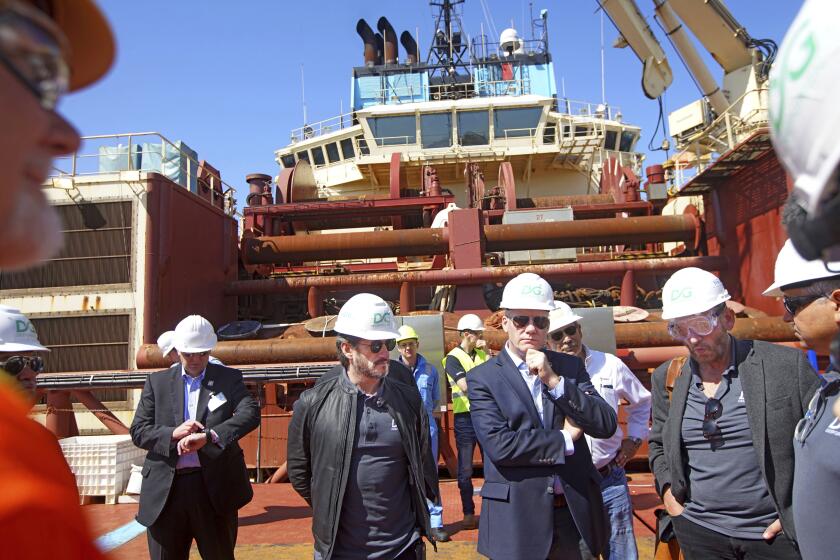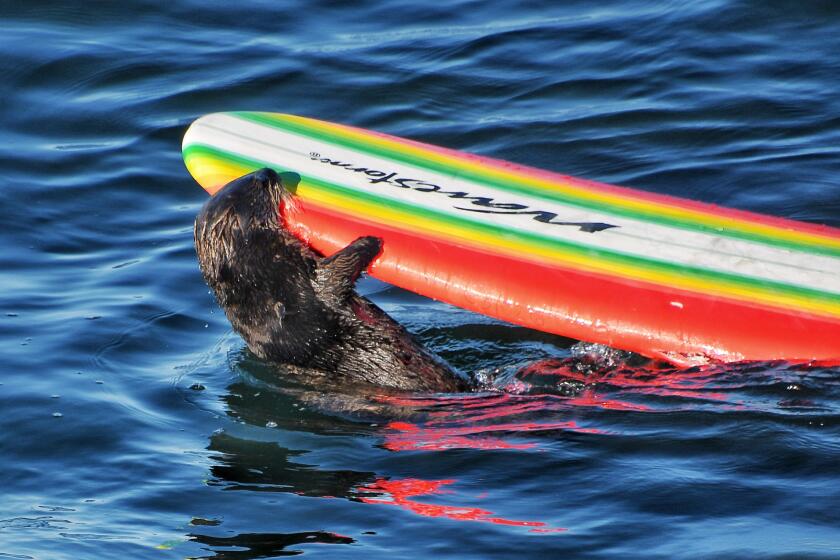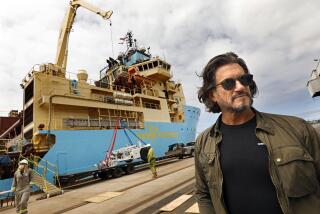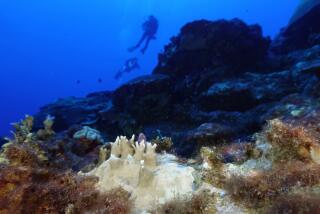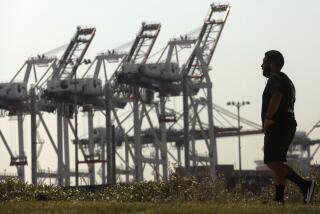California and Hawaii lead charge against deep-sea mining of critical metals

As the global energy transition stokes demand for critical minerals, the International Seabed Authority has been meeting in Jamaica to debate the future of deep-sea mining, and whether the industry can begin scraping the ocean’s floor for battery metals.
The discussions come amid heavy criticism from environmental groups, who say the risk of damaging sea life is too great.
The proceedings are also occurring without a vote from U.S. officials, since the United States hasn’t signed the United Nations Convention on the Law of the Sea — the international law that created the authority.
But that hasn’t stopped California and several other states from establishing their own bans and restrictions. It also hasn’t stopped a group of Democratic lawmakers from calling on President Biden to place a moratorium on seabed mining.
“Seabed mining is not safe and it’s destructive,” said California Assemblymember Luz Rivas (D-North Hollywood), author of a 2022 law that bans the practice in state waters. “We shouldn’t be doing it anywhere, in any ocean, on any sea floor.”
Aggressive and impactful reporting on climate change, the environment, health and science.
But mining operations say the metals they plan to harvest, such as cobalt and nickel, will help grow the green economy and spare land habitats from disruption.
“The transition away from hydrocarbons is like Day 1, and we’ve got a long way to go,” said Gerard Barron, president of the Metals Co., or TMC, a Canadian mining company that is planning to harvest metals in the Pacific’s Clarion-Clipperton Zone — a 4,500-mile stretch of ocean between Hawaii and Mexico.
“If you start looking at all the other transportation forms and grid storage, and then you look at the demand coming from the industrialization of the developing world, if it ain’t grown, it’s mined,” he said.
Unprecedented numbers of gray whales are being spotted in San Francisco Bay, and nobody really knows why. Experts only have educated guesses about the prevalence of porpoises, dolphins and humpback whales too.
The bounty for such mining operations are polymetallic nodules — mineral spheres that are roughly the size of a baseball and found far offshore, thousands of feet below the ocean’s surface.
Since state waters extend just three miles offshore, restrictions passed by California, Washington, Oregon and Hawaii are largely toothless.
Still, opponents of seabed mining say the bans help send a message to the international community “that a sizable and powerful” contingent of the U.S. population objects to the practice, said Chris Lee, a Democrat in the Hawaii state Senate.
Mining firms want to scrape the seabed for minerals used in electric car batteries. Scientists worry about conflicts of interest with the gatekeeper to mining permits.
Also, a dozen Democratic lawmakers — including Reps. Sydney Kamlager-Dove, Zoe Lofgren and Jared Huffman of California, Ed Case of Hawaii and Raúl Grijalva of Arizona — have called on Biden to place a moratorium on seabed mining in federal waters. They say too little is known about the environmental effects to justify plowing ahead.
Barron and other mining advocates insist that deep-sea extraction causes much less environmental and social disruption than mining on land. He said that you can either dig on the seafloor, or “underneath equatorial rainforests. And that means that to get access to it, you need to push out the Indigenous people living there. You need to remove the rainforest, dig away the topsoil to get to the nickel bearing ore. And that’s just the beginning of the impacts, because then there is waste.”
Lee, the Hawaiian lawmaker, said the push to begin mining was premature and “frustrating,” especially since battery and magnet technologies are evolving toward using more affordable and plentiful materials, such as sodium.
He argues there are other options — including recycling and repair laws — that would allow for these materials to be harvested in ways that don’t involve mining or destroying ecosystems and habitats.
It’s why he’s working to create and support laws that not only provide incentives for recycling but also create roadblocks for the deep-sea mining industry. In 2023 he helped to pass a law that “basically gives authorization to our Department of Transportation to block our harbors from use for any vessels doing any undersea mining activity,” he said.
As mining companies look to the seafloor for critical metals, environmentalists say California’s Right to Repair law could help avert ecological harm.
In December, a TMC ship set to dock at Honolulu Harbor was turned away as protesters — native Hawaiians, navigators and environmentalists — gathered to express their displeasure.
Lee said his law was not enforced during this event because the ship turned of its own accord, but it does pose a deterrent.
Barron acknowledged the pushback from state lawmakers and Hawaiian natives, and said he’d met with some of the “elders,” had “listened to their thoughts,” but “there’s a lot of niche groups who have a lot of thoughts, right?”
He noted that his company is sponsored by the Pacific Island nations of Nauru, Kiribati and Tonga — “nations that were heavily impacted by climate change... and exploited for their natural resources” — and that they are looking to benefit from his company’s industry “through jobs and royalties and some economic opportunities.”
His company required sponsorship from a sovereign nation in order to apply for a license from the international governing body to mine the ocean’s floor.
The Jamaica-based authority is currently deciding how and whether to allow deep-sea mining as a growing number of nations voice concern. More than two dozen countries have called for a ban, pause or moratorium on deep-sea mining.
The authority, which is the global custodian for international deep waters, has granted 31 mining exploration contracts but has not authorized any exploitation as the debate continues. TMC has threatened to apply for permission before deep-sea mining rules and regulations are in place.
Barron said that despite Lee and others’ worries, his company is concerned about the environment and has sponsored and conducted studies showing its harvesting activities will cause only minimal disturbance. He referred a reporter to work from MIT that showed the sediment plumes — or underwater dust clouds — caused by mining machinery travel only a few meters, remaining relatively localized.
He said the result of driving over the sea floor with giant rakes and vacuum cleaners really won’t make all that much of a difference to deep-sea ocean habitat.
“There are a handful of different habitat types ... all of which are ubiquitous,” he said. “And what we will be doing is essentially converting one nodule-rich habitat into one that doesn’t have as many nodules. But both of those habitats are ubiquitous. So it’s simply transforming one into another and then providing the ability” for the disturbed habitat “to recolonize.”
Research has shown that at the depths where these nodules are found — between 9,000 and 12,000 feet below the surface — the darkness and pressure make recolonizing life a very slow process.
“Life down there just moves at a much, much slower pace,” said Douglas McCauley, an associate professor in the Department of Ecology, Evolution, and Marine Biology at UC Santa Barbara. “The oldest organism that we know on the planet lives in these ecosystems. That’s a black coral. Some of the specimens that scientists collected and dated were effectively born when people were building the pyramids.”
Otter 841, California’s most ornery sea mammal, has returned to waters off Santa Cruz. Authorities warn surfers and swimmers to steer clear of the creature.
Barron said that when his machines have plowed through, it has allowed the ecosystem to “thrive.”
“If you think about the life down there as measured in grams per square meter, there’s around 10 grams of biomass ... and 80% of that is bacteria,” he said. “So, if you are a sessile organism sitting on a nodule, and we collect you, then that’s probably the end of life. But for the bacteria, you know, what our studies are proving is that actually there may be a net positive impact ... a little bit like tilling the soil.”
He said their work, which is not published, shows that when they went back to test areas they’d mowed over 12 months before, they found the biomass was “thriving.”
Asked how they could tell that the bacteria and other organisms were thriving, he said, “They’re there. They’re alive and ... if they weren’t ... they’d have a different appearance.”
McCauley said he could not comment on these observations because the work hasn’t been published, but pointed to a variety of organisms that have been discovered at these depths — “crystalline sponges that look like something out of Tiffany’s brochure; ghost white “Casper” octopus that have more hits on YouTube than I ever will, and gummy squirrels.”
He also emphasized that there is still little known about how animals, such as beaked whales and squid, use this ecosystem.
“The impacts that keep me up at night in ocean mining are those associated with the mining wastewater plumes that would be created in the middle of the sea,” he said. “Gigantic, moving plumes that could smother the Pacific’s best tuna fishing grounds, the planet’s largest daily migration of life from the deep to the surface across the ocean’s twilight zone, a region that contains the most abundant vertebrate life on the planet, and is traversed by whales, sea turtles and giant squid.”
And he said, research shows deep-sea mining “may become the loudest activity ever in the ocean and a massive source of noise pollution.”


